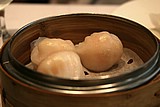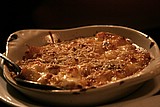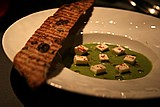Home |
Restaurants by City
|
Food Photography |
Archive | Philosophy |
![]()
Right now we are eating in Seattle, Washington.
|
Monday
2005
Permalink
|
Eating in Maui Part I - Tasted on May 28-June 1, 2005 It takes me awhile to learn things. I suppose that's part human nature, and part me being relatively slow. I know that for example the traditional sources of food expertise in my hometown of Seattle commonly recommend places to eat as good that are simply not. I know that food that caters to tourists is likely to be of lowest common denominator. I know that I generally haven't enjoyed food in Hawaii. I know that typically restaurants at hotels are subsidized and while it's not scientifically proven, I tend to think it makes them not try as hard. I know all these things. But yet, when we went to Maui I seemed to throw them out the door. And I do this not just when I travel to Maui but when I travel to other places. And I throw out all this knowledge because I assume (typically incorrectly) that if there's a gem somewhere in the place I'm visiting, a true culinary find, then someone will have written profusely about it and I'll find that description on the web. The trouble is, there's so much crap on the web that it's basically impossible to know who to trust, which I guess is why I started this site in the first place. Still it has taken me forever to learn this lesson. The food experiences we had in our short hop to Maui were overall, not good. Not good at all. To be fair, the Bistro Molokini poolside restaurant at the Grand Wailea made kickass Oreo Milkshakes and Lava Flows (yes I'm comfortable with my masculinity) - lots of ice cream. Ferraro's at the Four Seasons did actually try to make decent food, but overall things were uninspired. The sole exceptions being the artichoke spread at the beginning and the beef carpaccio generously doused in truffle oil. Still those weren't enough to carry the meal beyond just barely above average hotel restaurant Italian food. At one point we were so desperate for some good raw fish (we were on an island in the middle of the Pacific Ocean for god's sake) that we went to the super market and bought some pre-done poke - raw ahi + soy sauce + other stuff. We gorged. It wasn't great, but it hit the spot especially after we were told that there were no sushi restaurants open for lunch anywhere on the west side of Maui.
We should have known the second we saw that David Paul's Lahaina Grill was located in the heart of super-touristy Lahaina that it wasn't going to be anything to write home about. The super mediocre pan-Asian, creole-influenced mish-mash was the typical mess that "adventurous" eaters in the U.S. like to call "good". I got depressed. This may all sound snobbish and I don't really care. It's not that a restaurant by definition sucks because it's in the touristy area. But it sure is likely. And while I'm sure it's been clear to all of you for some time, almost by definition the traditional sources for food recommendations on the web are all geared for visitors. This is true of every destination, not just Maui. I admit this is pretty close to, if not actual, whining, but nonetheless, it is damn hard to get recommendations of good restaurants from people you really trust. I admit, I'm bad at judging where to go to eat when I've never been there before. At a certain point during our trip I wondered aloud if there would be any good food to be found on Maui. And then of course I bit into some fresh pineapple. Pineapple on Maui is pretty much the best you've ever eaten in your entire life. Fleshy, sweet, sour, crisp, and unbelievably juicy. Not syrupy in anyway, and closer to white than yellow in color. Pineapple takes on a whole new meaning when you eat it there. (Stay tuned for our next post where this entry concludes.)
|
|
Our Sponsors
Free Car Listings Hot Tubs Stools Saunas Bar Stools - Calendar and Event Schedules - Food Events and Calendars - Wine Events and Calendars - Digital Photography Resources - Software for Advertisers - Jewish Gifts and Judaica - Howard Stern Podcast - ponytailed blogger Jonathan Schwartz

Browse tastingmenu
Home |
Restaurants by City X |
Food Photography |
Archive | Philosophy |
![]()
Free eBooks: All About Apples
| Autumn Omakase
More:
Discussion |
Cool Food T-Shirts |
Ingredients
| Markets |
Recipes
Search |
Blog FAQ |
Other
Blogs
Best of tastingmenu
|
City View
Entry: July 6, 2006 |
Blue Plate
Entry: June 19, 2006 |
L'Atelier de Joël Robuchon
Entry: July 18, 2006 |
Browse by City
Boston | Chicago | Houston | Las Vegas | Los Angeles | Maui | New York | Philadelphia | Portland | San Francisco | Seattle | Toronto | Utah | Vancouver | Washington D.C.
Bangkok | Beijing | Hong Kong | Seoul | Tokyo
Amsterdam | Berlin | Italy | London | Madrid | Paris | Vienna
Browse by Month
2006
2005
2004
2003
2002
2001
Comments, questions, or feedback:
info / at / tastingmenu / dot / com
All pages Copyright (c) 2001-2006 tastingmenu.com
Last modified 01/30/07.
_small.jpg)



